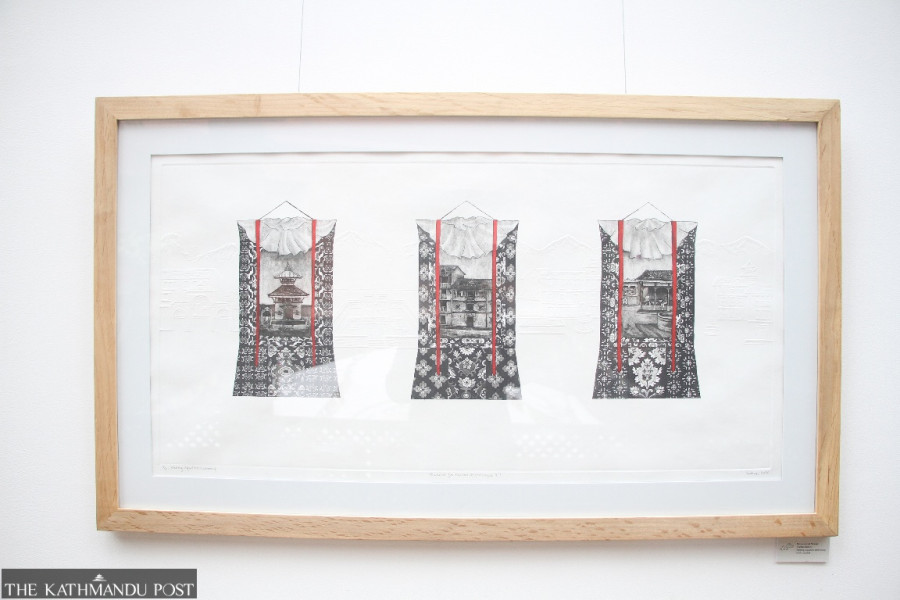Arts
Entrapped in their beauty
Artist Sushma Shakya’s latest solo exhibition, ‘Chen: Overlooked Reality,’ attempts to emphasise the relationship between nature’s five elements, humans, and their houses.
Srizu Bajracharya
For the last few weeks, Thamel’s art galleries have seen a flurry of art exhibitions. One such gallery in Thamel that has an ongoing art exhibition is Dalai-La Art Space. Titled ‘Chen: Overlooked Reality’, this exhibition by Sushma Shakya, a visual artist from Patan, features 23 artworks and covers four series, all of which emphasise the old architecture of the Valley that integrated the philosophy of the five elements of nature: earth, fire, water, air and space (ether), and how harmful human activities damage the natural environment.
Her series titled ‘Reverence for Newari Architecture’ features three miniature paintings—of a temple, a house, and a communal living set-up. The artwork’s canvas paper is embossed inconspicuously with an emblem of a close-knit Newa settlement with mountains in the background.
In each of her artworks dating from 2017 to 2022, Shakya focuses on telling viewers how the old homes and temples of Kathmandu Valley were built by balancing the ecosystem. And by maintaining a balance with nature, the architecture also sought to give people contentedness. The thesis of her idea is that when chhen (home/house in Nepalbhasa) is built by maintaining the harmony of the five elements, it provides humans with an ideal environment to live in.
In her series ‘Pancha Tattva’ (five elements), Shakya tries to illustrate how human activities disrupt the balance of nature’s five elements and exacerbated global warming and climate change. She incites that even the air we breathe has become unnatural. In her work titled ‘Mandala of Nature’, Shakya shows a plant—which is symbolic of life—at the centre of a mandala. The imagery perhaps is to remark the idea that the kind of life we lead determines the balance of nature.
The artworks in the exhibition make it apparent that Shakya is influenced by Buddhism and has a particular fondness for the Valley’s old architecture, which placed a lot of emphasis on communal exchange. In many of her artworks, she tries to stress the design of bahas and bahis to highlight how they emphasise human relationships and the functionality of space.
Shakya’s works featured in the exhibition are aesthetically pleasing. Her prints are beautiful, especially her work’ Reverence of Newari Architecture’. Her mixed media series ‘Overlooked Reality’ features three artworks, and they suitably highlight the fine craft of Newa architecture.
However, grasping the meaning of all the artworks in the exhibition isn’t an easy task. Viewers will find it difficult to comprehend the concepts and logics Shakya’s artworks explore. It’s hard to follow the concept of the mandala and the five elements and imagine the balance of the five elements (the harmony she wants to emphasise with her works).
And it is possibly because her works diverge time and again into different directions instead of converging to one particular idea. It’s difficult to see the five elements of nature embedded in her structures. When admiring the architecture of structures and settlements in her works, we are hardly thinking of the law of nature—which shouldn’t be the case as that is what the exhibition’s idea sits on.
Unless we read the artist’s statement (written on a postcard), we cannot pinpoint the overlooked reality (which could be the five elements or just the old sustainable techniques of building houses) the exhibition is trying to explore. It does make sense to reminisce about old architecture in a world that is increasingly becoming concrete and replacing the nature of things. But we cannot overlook that five elements still continue to exist in the new architecture that surrounds us. The five elements are the law of existence itself, so the comparison of what we are missing in the architecture that surrounds us today and why the artist emphasises in five elements isn’t clear.
The title of the exhibition itself, ‘Chen: Overlooked Reality’ misguides us to think of emotions and human/communal relations in reference to the word house. But it will be a surprise that ‘Chhen’ in the title doesn’t adhere to ‘home or house’ but simply architecture. What is missing in the exhibition is also humans and their interactions. And so, we keep looking at Shakya’s work from a distance as though we are only looking at photographs of house structures.
Had the artist and the exhibition’s curator provided additional supporting information to make it easier for viewers to understand the artworks, the exhibition would have become more impactful. At this moment in the art scene, there is a dire need for artists and curators to work together to make it easier for viewers to enter their works and understand them, thereby inspiring them to explore more art.
And it is not just detailed information about artworks that provides support to viewers to enter an exhibition’s experience; sometimes, it’s also about artists and curators rechecking, revising, and monitoring if they have enough artworks to say what they want to say with the exhibition.
Perhaps, Shakya should have added some more artworks to establish people’s relation with the architecture she presents and the interaction of the five elements.
Shakya’s ‘Chen: Overlooked Reality’ felt like it needed more artwork to say why the five elements matter and how humans, houses and the elements are interconnected. While the exhibition's overall theme is interesting, it fails to pull it off.
‘Chen: Overlooked Reality’ will be on display until June 30 at Dalai-La Art Space in Dalai-La Boutique Hotel, Thamel.




 22.65°C Kathmandu
22.65°C Kathmandu










